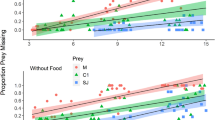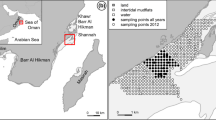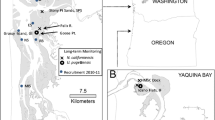Abstract
Mud crabs of the genus Scylla are commercially important mangrove residents that are extensively fished throughout their range in the Indo-West Pacific. Despite this high level of exploitation very little is known about the population dynamics of any of the Scylla species. The present study concentrated on an exploited population of Scylla paramamosain in a natural estuarine mangrove on Can Coc Island in the mouth of the Hau River, Mekong Delta, Vietnam. A total of 6,114 juvenile crabs captured on the seaward mangrove fringe were internally tagged by injection of coded microwire tags and released over a period of 29 days. Recaptures were monitored over the following 144 days. There was little migratory movement within the estuary; of 285 recaptured crabs, 93% were recovered within the island mangrove study area and only two individuals were recovered from mangroves lining the opposite mainland riverbanks. A von Bertalanffy growth function was fitted to growth increment data from recaptured crabs, with Lmax = 150 mm to derive a growth constant, k = 2.39 year−1. The theoretical age at which carapace width is zero (t0) was derived from known size at recruitment at instar 1, giving a value of −0.0095 years. Previous studies of the same population have shown that female S. paramamosain reach maturity at a mean size of 102 mm carapace width. The present study indicates that they attain this size at around 160 days from first settlement in the mangrove fringe. Abundance of juvenile crabs in the study area was estimated by the Petersen method as 1,101,500 (95% CI 4,17,300–1,785,800, representing 1,102 crabs ha−1 of mangrove. Estimation of mortality from tag returns and from the age-catch curves during a period of constant recruitment were comparable (Z = 1.11 and 1.04 month−1, respectively). Fishing only accounted for 14% of total mortality, suggesting that at the time exploitation was not at a critical level despite the apparent high level of fishing activity.






Similar content being viewed by others
References
Angell CA (1992) Summary of the proceedings of the seminar on mud crab culture and trade. In: Angell CA (ed) Seminar on mud crab culture and trade, Bay of Bengal program. BOBP Report, Madras, pp 1–2
Arriola FJ (1940) A preliminary study of the life history of Scylla serrata (Forskal). Philipp J Sci 73:437–458
Barnes DKA, Dulvy NK, Priestly SH, Darwall WRT, Choisel V, Whittington M (2002) Fishery characteristics and abundance estimates of the mangrove crab Scylla serrata in southern Tanzania and northern Mozambique. S Afr J Mar Sci 24:19–25
Bennett DB, Brown CG (1983) Crab (Cancer pagurus) migrations in the English Channel. J Mar Biol Ass UK 63:371–398
Brey T (1999) Growth performance and mortality in aquatic benthic invertebrates. Adv Mar Biol 35:153–223
Brey T (2001) Population dynamics in benthic invertebrates. A virtual handbook. Version 01.2. Alfred Wegener institute for polar and marine research, Germany. http://www.awi-bremerhaven.de/Benthic/Ecosystem/FoodWeb/Handbook/main.html
Christensen SM, Macintosh DJ, Phuong NT (2004) Pond production of the mud crabs Scylla paramamosain (Estampador) and S. olivacea (Herbst) in the Mekong Delta, Vietnam, using two different supplementary diets. Aqua Res 35:1013–1024
Debnath R, Choudhury A (1988) Population estimation of horseshoe crab Tachypleus gigas by capture-recapture method at Chandipur sea shore (Orissa), India. J Mar Biol Ass India 30:8–12
Eiji M, Masayoshi S (1991) Migration of adult hair crab, Erimacrus isenbeckii, in the coastal waters of southwestern Hokkaido observed by tagging experiments. Sci Rep Hokkaido Fish Exp Stn 55:123–130
Estampador EP (1949) Studies on Scylla (Crustacea: Portunidae). I. A revision of the genus. Philipp J Sci 78:95–108
Fitz HC, Wiegert RG (1992) Local opulation dynamics of estuarine blue crabs - abundance, recruitment and loss. Mar Ecol Prog Ser 87:23–40
Fujita H, Takeshita K, Kawasaki S (1973) Seasonal movement of adult male king crab in the eastern Bering Sea revealed by tagging experiment. Bull Far Seas Fish Res Lab 9:79–87
Gulland JA (1983) Fish stock assessment: A manual of basic methods. FAO/Wiley, Rome, pp 223
Hill BJ (1975) Abundance, breeding and growth of the crab Scylla serrata in two South African estuaries. Mar Biol 32:119–126
Hill BJ (1994) Offshore spawning by the portunid crab Scylla serrata (Crustacea, Decapoda). Mar Biol 120:379–384
Hill BJ, Williams MJ, Dutton P (1982) Distribution of juvenile, subadult and adult Scylla serrata (Crustacea: Portunidae) on tidal flats in Australia. Mar Biol 69:117–120
Hyland SJ, Hill BJ, Lee CP (1984) Movement within and between different habitats by the portunid crab Scylla serrata. Mar Biol 80:57–61
Keenan CP, Davie PJF, Mann DL (1998) A revision of the genus Scylla de Haan, 1833 (Crustacea : Decapoda : Brachyura : Portunidae). Raffles B Zool 46:217–245
King M (1995) Fisheries biology, assessment and management. Blackwell, Oxford, pp 341
Kosuge T (2001) Brief assessment of stock of mud crabs Scylla sp. in Matang Mangrove Forest, Malaysia and proposal for resources management. Jarq-Jpn Agr Res Q 35:145–148
Le Vay L (2001) Ecology and management of mud crabs, Scylla spp. Asian Fish Sci 14:101–111
Le Vay L, Ngoc Ut V, Jones DA (2001) Seasonal abundance and recruitment in an estuarine population of mud crabs, Scylla paramamosain, in the Mekong Delta, Vietnam. Hydrobiologia 449:231–239
Lee C (1992) A brief overview of the ecology and fisheries of the mud crab, Scylla serrata, in Queensland. In: Angell CA (ed) Seminar on mud crab culture and trade, Bay of Bengal program. BOBP, Madras (India), pp 65–70
Liong PC (1995) Crab culture—present status, future prospets. In: Nombiar KPP, Singh T (eds) Aquaculture towards the 21st century: Proceedings of the Infofish AQUATECH, 1994 conference. Infofish, Kuala Lumpur, Columbo, Sri Lanka, pp 90–95
Macintosh DJ, Thongkum C, Swamy K, Cheewasedtham C, Paphavisit N (1993) Broodstock management and the potential to improve the exploitation of mangrove crabs, Scylla serrata (Forskaal), through pond fattening in Ranong, Thailand. Aquacult Fish Manag 24:261–269
Macnae W (1968) A general account of the fauna and flora of mangrove swamps and forests in the Indo-West-Pacific region. Adv Mar Biol 6:73–270
Miller RJ (1990) Effectiveness of crab and lobster traps. Can J Fish Aquat Sci 47:1228–1251
Moser SM, Macintosh DJ, Prinpanapong S, Tongdee N (2002) Estimates of growth of the mud crab Scylla olivacea in the Ranong mangrove ecosystem, Thailand, based on a tagging and recapture study. Mar Freshw Res 53:1083–1089
Nandi NC, Dev Roy MK (1990) Burrowing activity and distribution of Scylla serrata (Forskal) from Hooghly and Matla estuaries, Sundarban, West Bengal. J Bombay Nat Hist Soc 88:167–171
Overton JL, Macintosh DJ (2002) Estimated size at sexual maturity for female mud crabs (Genus Scylla) from two sympatric species within the Ban Don Bay, Thailand. J Crust Biol 22:790–797
Overton JL, Macintosh DJ, Thorpe RS (1997) Multivariate analysis of the mud crab Scylla serrata (Brachyura: Portunidae) from four locations in Southeast Asia. Mar Biol 128:55–62
Pianka E.R (1970) On r- and K- selection. Am Nat 104:592–597
Ricker WE (1975) Computation and interpretation of biological statistics of fish populations. Bull Fish Res Board Can 191:382
Robertson WD (1989) Factors affecting catches of the crab Scylla serrata (Forskal) (Decapoda, Portunidae) in baited traps-soak time, time of day and accessibility of the bait. Est Coast Shelf Sci 29:161–170
Robertson WD, Piper SE (1991) Population estimates of the crab Scylla serrata (Forskal, 1755) (Decapoda, Portunidae) in two closed estuaries in Natal, South-Africa, from mark-recapture methods. S Afr J Mar Sci 11:193–202
Sasekumar A (1974) Distribution of macrofauna on a Malayan mangrove shore. J Anim Ecol 43:51–69
Seber GAF (1982) The estimation of animal abundance and related parameters. Oxford University Press, New York, pp 672
Trino AT, Millamena OM, Keenan C (1999) Commercial evaluation of monosex pond culture of the mud crab Scylla species at three stocking densities in the Philippines. Aquaculture 174:109–118
Ut VN (2002) Assessment of the feasibility of stock enhancement of mud crabs, Scylla paramamosain, in the Mekong Delta, Vietnam. PhD. University of Wales, Bangor, pp 288
Ut VN, Le Vay L, Nghia TT, Hanh TTH (in press-a) Development of nursery culture techniques for the mud crab Scylla paramamosain. Aquacult Res
Ut VN, Le Vay L, Nghia TT, Walton MEM (in press-b) Comparative performance of hatchery-reared and wild Scylla paramamosain (Estampador, 1949) in pond culture. Aquacult Res
Walton MEM (2006) The effect of habitat on the ecology and fisheries of Scylla spp. in Vietnam and the Philippines. PhD. University of Wales, Bangor pp 162
Walton MEM, Le Vay L, Lebata JH, Binas J, Primavera JH (2006a) Seasonal abundance, distribution and recruitment of mud crabs (Scylla spp.) in replanted mangroves. Est Coast Shelf Sci 66:493–500
Walton MEM, Le Vay L, Truong LM, Ut VN (2006b) Significance of mangrove–mudflat boundaries as nursery grounds for the mud crab, Scylla paramamosain. Mar Biol DOI: 10.1007/s00227-006-0267-7
Walton MEM, Samonte-Tan G, Primavera JH, Edwards-Jones G, Le Vay L (In press) Are mangroves worth replanting? The direct economic benefits of a community-based reforestation project. Environ Conserv
Williams MJ, Hill BJ (1982) Factors influencing pot catches and population estimates of the portunid crab Scylla serrata. Mar Biol 71:187–192
Winkler G, Greve W (2002) Laboratory studies of the effect of temperature on growth, moulting and reproduction in the co-occurring mysids Neomysis integer and Praunus flexuosus. Mar Ecol Prog Ser 235:177–188
Acknowledgments
This study was supported by the European Commission INCO DC contracts ERB-IC18-CT97-0189 and ECA4-CT-2001-10022. The authors are grateful for the helpful comments from three anonymous reviewers of a previous version of this manuscript.
Author information
Authors and Affiliations
Corresponding author
Additional information
Communicated by A. Atkinson, Cambridge.
Rights and permissions
About this article
Cite this article
Le Vay, L., Ut, V.N. & Walton, M. Population ecology of the mud crab Scylla paramamosain (Estampador) in an estuarine mangrove system; a mark-recapture study. Mar Biol 151, 1127–1135 (2007). https://doi.org/10.1007/s00227-006-0553-4
Received:
Accepted:
Published:
Issue Date:
DOI: https://doi.org/10.1007/s00227-006-0553-4




